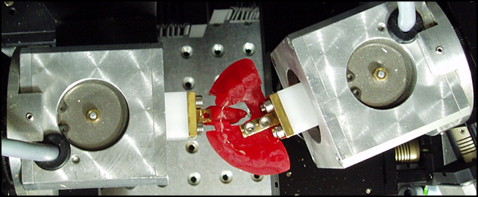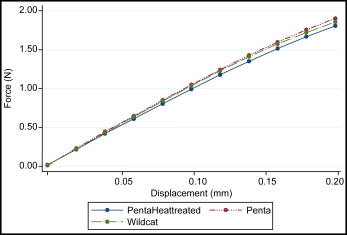Introduction
The aim of this article was to assess the effect of wire adaptation on the lingual surfaces of mandibular anterior teeth with 3 types of lingual retainers on the development of vertical and labiolingual forces.
Methods
Ten retainers (canine to canine) were constructed from each of the following wires: Wildcat 0.0195-in heat-treated 3-strand twist-flex wire (GAC, Bohemia, NY); Penta-one 0.0215-in 6-strand as received; and Penta-one 0.0215-in 6-strand after heat treatment at 350°C for 4 minutes (both, Masel Orthodontics, Carlsbad, Calif). The retainers were bonded on each tooth of an acrylic resin model, and the model was installed in the Orthodontic Measurement and Simulation System. The vertical and labiolingual forces generated were measured for wire displacements up to 0.2 mm in 0.02-mm increments.
Results
Wire displacement of 0.2 mm exerted forces as high as 1 N on the teeth. In the vertical direction, the highest force levels were recorded for the as-received Penta-one 0.0215-in and the lowest from its heat-treated counterpart. In the horizontal plane, the as-received Penta-one 0.0215-in exerted the highest forces.
Conclusions
The forces recorded from the lingual retainer wires during 0.2-mm simulated intrusion-extrusion and buccal-lingual movements might generate high forces that exceed 1 N and be large enough to produce unwanted tooth movement during retention. The only significant determinant of the generated forces was the amount of wire displacement and not the type of wire used in this study.
Despite the numerous case reports, reviews, and opinion articles, there is still no agreement in the literature with regard to a protocol for retention. The increased risk of relapse in the anterior segment is the indication for a fixed retainer, and several suggestions for the placement of the different types of bonded fixed retainers have been proposed. However, even with bonded retainers in place, relapse can still occur.
The use of multi-stranded wires for the construction of fixed retainers has been proposed based on their ability to allow for the physiologic movement of the teeth, whereas their braided surface offers increased mechanical retention with the adhesive. A recent study showed that 0.0195-in multistranded retainers are efficient in preventing relapse of the mandibular anterior teeth. However, in 3% to 5% of patients, unexpected posttreatment changes in the mandibular anterior teeth have been reported. Specifically, torque differences between 2 adjacent incisors were observed, along with increased buccal inclination and movement of a mandibular canine. These changes cannot be characterized as relapse, since they were not present before or after orthodontic treatment. The exact reason for these changes is unknown, and they could probably be attributed to an active component of the wire due to either an elastic deflection caused by the clinician or a mechanical deformation from masticatory forces. Multi-stranded wires generate lower forces that dissipate over longer periods of time. Because of the poor formability of these wires, inaccuracies during wire contouring and adaptation to the curved lingual surface of mandibular teeth could lead to tooth movement.
The purpose of this study was to evaluate the effect of wire displacement on the forces generated in the vertical and horizontal planes with 3 types of lingual fixed retainers.
Material and methods
The Orthodontic Measurement and Simulation System (OMSS) was used for the in-vitro assessment of the stresses developed with various retainer wires. For this purpose, the OMSS has 2 stepping motor-driven positioning tables equipped with force-moment transducers, monitored by a personal computer that controls the measurements. Absolute measurements were recorded of the forces and moments generated by an orthodontic appliance, when the positioning tables were moved along a specified path.
An orthodontic stone model of the mandibular anterior segment, with an ideal, leveled, and aligned dental arch, was used for the construction of the retainers. Multiple copies of this model were used, and each retainer was contoured to its individual working model. Ten retainers were constructed from each of the following wires by an experienced technician: (1) Penta-one 0.0215-in 6-strand coaxial (Masel Orthodontics, Carlsbad, Calif) stainless steel wire, as received; (2) Penta-one 0.0215-in 6-strand coaxial (Masel Orthodontics) stainless steel wire, heat-treated at 350°C for 4 minutes; and (3) Wildcat 0.0195-in heat-treated 3-strand twist-flex steel wire (GAC, Bohemia, NY).
A copy of the initial stone model was constructed from acrylic resin (Palavit G, Heraeus Kulzer, Hanau, Germany). This model was split into 2 segments to consolidate the lateral incisor. An appropriate adaptor was fixed on each model segment, and the system was mounted to the positioning tables of the OMSS ( Fig 1 ). On the lingual surface of every tooth, a small hole was drilled with a bur for retention of the resin (diameter, 2 mm; depth, 2 mm; distance between the holes, 4 mm).

In the absolute measurement mode, the dental arch was initially leveled, and the retainer was bonded on each tooth (canine to canine) by using equal amounts of light-cured composite (Flow Tain, Reliance Orthodontic Products, Itasca, Ill). During the measurement procedure, the lateral incisor was initially extruded and then protruded up to 0.2 mm for both configurations. The forces generated in this segment were measured at every 0.02-mm incremental movement. For the objectives of this study, only the intrusive (Fz) and labiolingual (Fx) forces were used for the evaluations of the lingual retainers. The remaining force (Fy) and moment (Mx, My, Mz) components were adjusted to zero. All procedures were performed by the first author (I.S.).
Statistical analysis
Statistical analysis was performed by using analysis of covariance (ANCOVA) with the generated force serving as the dependent variable, and type of wire and amount of intrusion as the categorical and continuous explanatory variables, respectively. All statistical analyses were performed with Stata software (version 10.1, StataCorp, College Station, Tex).
Results
The mean force results for Fz in the vertical plane for the wires are shown in Table I . The lowest values (–0.95 N) were recorded for the heat-treated Penta-one 0.0215-in wire.
| Force (N) | ||
|---|---|---|
| Wire type | Mean | SD |
| Penta-one heat treated | −0.95 | 0.53 |
| Penta-one | −1.01 | 0.61 |
| Wildcat | −0.99 | 0.60 |
Figure 2 depicts the intrusion force generated on the lateral incisor per wire type and displacement for a range of 0.2 mm (0.0-0.2 mm) at 0.02-mm increments measured for each retainer with the highest forces. Obviously, because of construction differences and differences in the amount of composite, maximum forces were almost twice as high as mean values. Greater variations of the mean force levels of Fx in the horizontal plane were registered for the 3 retainer types ( Table II ). The as-received Penta-one 0.0215-in exerted the highest force (1.59 N).

| Force (N) | ||
|---|---|---|
| Wire type | Mean | SD |
| Penta-one heat treated | 1.49 | 0.93 |
| Penta-one | 1.59 | 0.97 |
| Wildcat | 1.35 | 0.83 |
Stay updated, free dental videos. Join our Telegram channel

VIDEdental - Online dental courses


